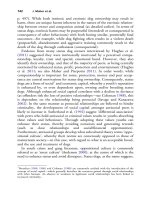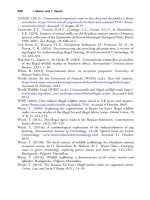The palgrave international handbook of a 286
Bạn đang xem bản rút gọn của tài liệu. Xem và tải ngay bản đầy đủ của tài liệu tại đây (29.04 KB, 1 trang )
Animal Racing: Shifting Codes of Canadian Social Tolerance
283
Stampede horses. Specifically, it allows veterinarians to police the health of
horses, and to regulate the frequency of their participation. Through a microchip inserted under the animal’s skin, regulators can ensure that competitors
are not ‘stretching’ or breaking the rules that have been implemented to
protect horses (such as the rules that prevent over-use of a horse and preventing
unhealthy or unfit horses from competing—discussed below).
In addition to such partnerships and commissions, all clearly indicative of an
ongoing, and importantly, surveilled sportization process, in 2011 the Calgary
Stampede undertook a number of significant rule and safety changes to chuckwagon racing, making that year particularly interesting to look at through the
lens of sportization. These rules include limiting the use of horses in chuckwagon racing to four consecutive days (to lower the risk of injury and accidents
from fatigue or over-use), requiring that horses used in a race be identified ‘prerace’ so that they can be examined by a veterinarian before running (to prevent
an unfit horse from racing), reducing the number of outriders from four to two
(to decrease the number of horses on the track during a race), and increasing
track maintenance by harrowing the track after every second race (to improve
footing, and therefore safety, for the horses) (Calgary Stampede 2015b). These
rule changes persist as the focus of media attention and debate, so much so that
one news article suggested that the 2011 Stampede ‘ . . . will likely be remembered as the year new animal care rules were instituted and declared a tentative
success even in the wake of two horse deaths’ (Stone and Tetley 2011, p. A1). It
is also important to note that not only has the Stampede implemented these
rules, but that it has also widely publicized these changes throughout the local
and national media. The sheer number of articles which reference the rule
changes illustrate the important role that rules and regulations play in the
debate over horse-use. These examples suggest that the Calgary Stampede has
attempted to legitimize the continued existence of chuckwagon racing as ‘sport’
by implementing and publicizing a variety of rules aimed at minimizing the
violence (by way of injuries and fatalities), so as to fall within a socially
acceptable level. Clearly, what is at stake in programs such as ‘Fitness to
Compete’ is as much about marketing and public image as it is about animal
safety, especially in the face of ongoing harm to horses.
Conclusion
As an example of how modern societies are increasingly reconciling questions
of humanity against common practices that harm animals, this chapter examines a cultural institution of the Canadian West—the Calgary Stampede. Using









